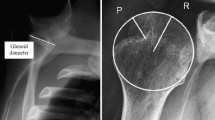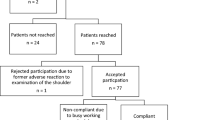Abstract
It would be a great advantage if it were possible to categorise the patients with first time dislocations to an initial treatment with the most beneficial outcome. MRI could be a useful method for finding lesions after shoulder dislocation. Fifty-eight patients with traumatic anterior shoulder dislocation were treated by closed reduction and were examined by MRI after a maximum of 2 weeks. The hemarthrosis or effusion present in the joint after the primary dislocation could be used as a contrast for arthrography to identify the lesions present on MRI. At follow-up more than 8 years later, the MRI findings were compared to the shoulder function, shoulder stability, Rowe score and Western Ontario Shoulder Instability Index (WOSI). Besides the age of the patient being above 30, the MRI findings analysed showed that an isolated fracture of the major tubercle, as well as a bony Bankart lesion are prognostic factors for a good functional result and a stable shoulder after a primary dislocation. The glenoid rim fracture was only detected on plain radiographs in 6 out of 10 findings on MRI. MRI findings of a gleniod rim fracture, equal to a bony Bankart lesion, were found to be a prognostic factor for stability and a good functional outcome.



Similar content being viewed by others
References
Antonio GE, Griffith JF, Yu AB, Yung PS, Chan KM, Ahuja AT (2007) First-time shoulder dislocation: high prevalence of labral injury and age-related differences revealed by MR arthrography. J Magn Reson Imaging 26:983–991
Arciero RA, Wheeler JH, Ryan JB, McBride JT (1994) Arthroscopic Bankart repair versus nonoperative treatment for acute, initial anterior shoulder dislocations. Am J Sports Med 22:589–594
Bach BR, Warren RF, Fronek J (1988) Disruption of the lateral capsule of the shoulder. A cause of recurrent dislocation. J Bone Joint Surg Br 70:274–276
Baker CL, Uribe JW, Whitman C (1990) Arthroscopic evaluation of acute initial anterior shoulder dislocations. Am J Sports Med 18:25–28
Bankart ASB (1923) Recurrent or habitual dislocation of the shoulder joint. Br Med J 2:1132–1133
Bigliani LU, Newton PM, Steinmann SP, Connor PM, McLlveen SJ (1998) Glenoid rim lesions associated with recurrent anterior dislocation of the shoulder. Am J Sports Med 26:41–45
Bigliani LU, Pollock RG, Soslowsky LJ, Flatow EL, Pawluk RJ, Mow VC (1992) Tensile properties of the inferior glenohumeral ligament. J Orthop Res 10:187–197
Habermeyer P, Gleyze P, Rickert M (1999) Evolution of lesions of the labrum-ligament complex in posttraumatic anterior shoulder instability: a prospective study. J Shoulder Elbow Surg 8:66–74
Hintermann B, Gachter A (1995) Arthroscopic findings after shoulder dislocation. Am J Sports Med 23:545–551
Hovelius L (1982) Incidence of shoulder dislocation in Sweden. Clin Orthop Relat Res 166:127–131
Hovelius L (1987) Anterior dislocation of the shoulder in teen-agers and young adults. Five-year prognosis. J Bone Joint Surg Am 69:393–399
Hovelius L, Augustini BG, Fredin H, Johansson O, Norlin R, Thorling J (1996) Primary anterior dislocation of the shoulder in young patients. A ten-year prospective study. J Bone Joint Surg Am 78:1677–1684
Hovelius L, Eriksson K, Fredin H, Hagberg G, Hussenius A, Lind B, Thorling J, Weckstrom J (1983) Recurrences after initial dislocation of the shoulder. Results of a prospective study of treatment. J Bone Joint Surg Am 65:343–349
Hovelius L, Olofsson A, Sandstrom B, Augustini BG, Krantz L, Fredin H, Tillander B, Skoglund U, Salomonsson B, Nowak J, Sennerby U (2008) Nonoperative treatment of primary anterior shoulder dislocation in patients forty years of age and younger. A prospective twenty-five-year follow-up. J Bone Joint Surg Am 90:945–952
Ideberg R, Grevsten S, Larsson S (1995) Epidemiology of scapular fractures. Incidence and classification of 338 fractures. Acta Orthop Scand 66:395–397
Ito H, Takayama A, Shirai Y (2000) Radiographic evaluation of the Hill-Sachs lesion in patients with recurrent anterior shoulder instability. J Shoulder Elbow Surg 9:495–497
Itoi E, Hatakeyama Y, Sato T, Kido T, Minagawa H, Yamamoto N, Wakabayashi I, Nozaka K (2007) Immobilization in external rotation after shoulder dislocation reduces the risk of recurrence. A randomized controlled trial. J Bone Joint Surg Am 89:2124–2131
Jakobsen BW, Johannsen HV, Suder P, Sojbjerg JO (2007) Primary repair versus conservative treatment of first-time traumatic anterior dislocation of the shoulder: a randomized study with 10-year follow-up. Arthroscopy 23:118–123
Kim KC, Rhee KJ, Shin HD, Kim YM (2007) Estimating the dimensions of the rotator interval with use of magnetic resonance arthrography. J Bone Joint Surg Am 89:2450–2455
Kirkley A, Griffin S, McLintock H, Ng L (1998) The development and evaluation of a disease-specific quality of life measurement tool for shoulder instability. The Western Ontario Shoulder Instability Index (WOSI). Am J Sports Med 26:764–772
Kirkley A, Werstine R, Ratjek A, Griffin S (2005) Prospective randomized clinical trial comparing the effectiveness of immediate arthroscopic stabilization versus immobilization and rehabilitation in first traumatic anterior dislocations of the shoulder: long-term evaluation. Arthroscopy 21:55–63
Kralinger FS, Golser K, Wischatta R, Wambacher M, Sperner G (2002) Predicting recurrence after primary anterior shoulder dislocation. Am J Sports Med 30:116–120
Maquieira GJ, Espinosa N, Gerber C, Eid K (2007) Non-operative treatment of large anterior glenoid rim fractures after traumatic anterior dislocation of the shoulder. J Bone Joint Surg Br 89:1347–1351
Norlin R (1993) Intraarticular pathology in acute, first-time anterior shoulder dislocation: an arthroscopic study. Arthroscopy 9:546–549
Nyffeler RW, Jost B, Pfirrmann CW, Gerber C (2003) Measurement of glenoid version: conventional radiographs versus computed tomography scans. J Shoulder Elbow Surg 12:493–496
Reeves B (1969) Acute anterior dislocation of the shoulder. Clinical and experimental studies. Ann R Coll Surg Engl 44:255–273
Robinson CM, Jenkins PJ, White TO, Ker A, Will E (2008) Primary arthroscopic stabilization for a first-time anterior dislocation of the shoulder. A randomized, double-blind trial. J Bone Joint Surg Am 90:708–721
Rowe CR (1956) Prognosis in dislocations of the shoulder. J Bone Joint Surg 38-A:957–977
Rowe CR (1988) Evaluation of the shoulder. In: Rowe CR (ed) The shoulder. Churchill Livingstone, New York, pp 631–637
Sachs RA, Lin D, Stone ML, Paxton E, Kuney M (2007) Can the need for future surgery for acute traumatic anterior shoulder dislocation be predicted? J Bone Joint Surg Am 89:1665–1674
Salomonsson B, Ahlstrom S, Dalen N, Lillkrona U (2009) The Western Ontario Shoulder Instability Index (WOSI): validity, reliability, and responsiveness retested with a Swedish translation. Acta Orthop 80:233–238
Speer KP, Deng X, Borrero S, Torzilli PA, Altchek DA, Warren RF (1994) Biomechanical evaluation of a simulated Bankart lesion. J Bone Joint Surg Am 76:1819–1826
Suder PA, Frich LH, Hougaard K, Lundorf E, Wulff Jakobsen B (1995) Magnetic resonance imaging evaluation of capsulolabral tears after traumatic primary anterior shoulder dislocation. A prospective comparison with arthroscopy of 25 cases. J Shoulder Elbow Surg 4:419–428
Suder PA, Mikkelsen JB, Hougaard K, Jensen PE (1995) Reduction of traumatic secondary shoulder dislocations with lidocaine. Arch Orthop Trauma Surg 114:233–236
Taylor DC, Arciero RA (1997) Pathologic changes associated with shoulder dislocations. Arthroscopic and physical examination findings in first-time, traumatic anterior dislocations. Am J Sports Med 25:306–311
te Slaa RL, Brand R, Marti RK (2003) A prospective arthroscopic study of acute first-time anterior shoulder dislocation in the young: a five-year follow-up study. J Shoulder Elbow Surg 12:529–534
te Slaa RL, Wijffels MP, Brand R, Marti RK (2004) The prognosis following acute primary glenohumeral dislocation. J Bone Joint Surg Br 86:58–64
Urayama M, Itoi E, Sashi R, Minagawa H, Sato K (2003) Capsular elongation in shoulders with recurrent anterior dislocation. Quantitative assessment with magnetic resonance arthrography. Am J Sports Med 31:64–67
Valentin A, Winge S, Engstrom B (1998) Early arthroscopic treatment of primary traumatic anterior shoulder dislocation. A follow-up study. Scand J Med Sci Sports 8:405–410
Vermeiren J, Handelberg F, Casteleyn PP, Opdecam P (1993) The rate of recurrence of traumatic anterior dislocation of the shoulder. A study of 154 cases and a review of the literature. Int Orthop 17:337–341
Wintzell G, Haglund-Akerlind Y, Tengvar M, Johansson L, Eriksson E (1996) MRI examination of the glenohumeral joint after traumatic primary anterior dislocation. A descriptive evaluation of the acute lesion and at 6-month follow-up. Knee Surg Sports Traumatol Arthrosc 4:232–326
Zarins B, McMahon MS, Rowe CR (1993) Diagnosis and treatment of traumatic anterior instability of the shoulder. Clin Orthop Relat Res 291:75–84
Author information
Authors and Affiliations
Corresponding author
Rights and permissions
About this article
Cite this article
Salomonsson, B., von Heine, A., Dahlborn, M. et al. Bony Bankart is a positive predictive factor after primary shoulder dislocation. Knee Surg Sports Traumatol Arthrosc 18, 1425–1431 (2010). https://doi.org/10.1007/s00167-009-0998-3
Received:
Accepted:
Published:
Issue Date:
DOI: https://doi.org/10.1007/s00167-009-0998-3




